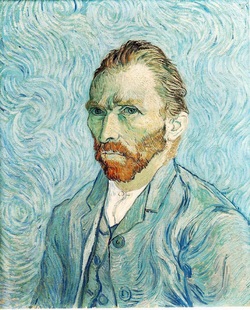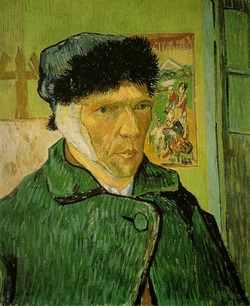"Mona Lisa" by Leonardo da Vinci
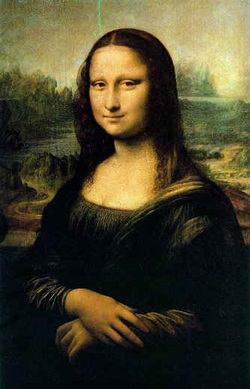
The Mona Lisa by Leonardo da Vinci is arguably the most famous painting in the world. The identity of the woman in the painting is one of the most disputed questions in art history. Some have argued that it is the artist's representation of himself as a woman. Others claim that the model for the painting was da Vinci's mother or one of his assistants. However, in 2008, a study at Heidelberg University in Germany confirmed the identity of the mystery woman. According to that study, Mona Lisa is "undoubtedly" Lisa Gherardini del Giacondo, the wife of a Florentine silk merchant named Franceso del Giacondo. This finding supports Georgio Vassari's identification of the model in "Lives of the Artists." Vasari was a 16th century painter and art historian, as well as close friend of da Vinci. However, because the work is unsigned and does not have any indication of the model's name, the true identity of Mona Lisa may never be certain. Perhaps it was da Vinci's intention to leave the identity a mystery so that people can let their imaginations flourish and think it is whoever they want.
"The School of Athens" by Raphael
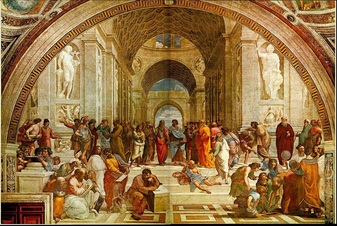
Raphael's The School of Athens is one of the most famous Renaissance paintings. Frescoed into the Vatican apartments during the reign of the worldy patron of the arts, Julius II, The School of Athens is a timeless painting. Raphael used the ancient Greek world as the setting for his fresco. He placed famous Greek scholars, some who did not live during the same time, in his painting, showing them conversing in Athens. Raphael hid these identities within the painting to show the greatness of the classical times and the intelligence of that time. He also added brilliant people of his own time, such as himself, Leonardo da Vinci, and Michelangelo. These people, dressed in the clothing of the classical times, are portrayed in the fresco that spans generations. Raphael purposefully added this as a tribute to these great minds. While the setting of the painting is in ancient times, the architecture, landscape, and brilliance of the fresco/painting/work of architecture can be identified as that of the Renaissance.
"Girl Before a Mirror" by Pablo Picasso

Why didn't Picasso just draw a mirror image in the girl on the left but instead showed a distorted darker version? Perhaps when we truly look into our own soul, we reflect that pain that burdens us that is not always on the surface. Each person has their surface identity but also carries a secret inner being that is often kept hidden from the world. Some people choose to forget the past, as troubling as it may be. What we allow everyone else to see is rarely a reflection of who we really are. The superficial outer appearance can be used to mask a person's true feelings. Because others cannot see beneath the surface, their only basis for judgement is what meets the eye. While you may be able to bury emotions deep within yourself, you can never avoid the truth when looking at your reflection.
"Campbell's Soup Can" by Andy Warhol
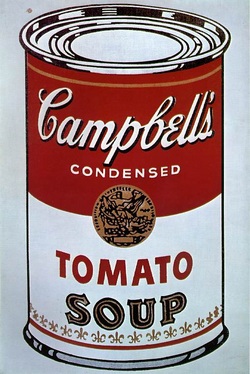
In the year 1962, a painting of a soup can was hardly considered fine art. The movement that Warhol pioneered, pop art, emphasized our strong identification with pop culture and marketing. Warhol's paintings, while not initially accepted, went on to become some of the most recognizable images in American art. Warhol, instead of denying the unspoken influence of popular imagery, embraced the contemporary dependence on commercial familiarity. Confirmed by his growing popularity, it became clear that Americans positively identified with the most recognizable brands in their daily lives. While some accused Americans of being at the disposal of the big corporations, the relationship between business and consumer would be one that served to benefit both parties. It endured and defined a generation of Americans.
"Man of Steel" by Troy Grzych
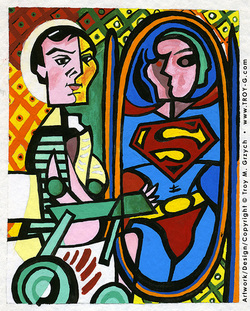
This painting, based off of Pablo Picasso's "Girl Before a Mirror" was done as a project by Grzych in which he had to illustrate a current affairs topic using a famous piece of artwork as inspiration. On his website, the artist writes that at the time, "Christopher Reeve had just suffered a tragic spinal cord injury that put him in (a) wheelchair and left him paralyzed." The artist goes on to say that Reeve's hard fought struggle to survive made him a real superman. His perseverance to defy the odds made him even more admirable than his role as Superman in the 1978 movie. The man in the wheelchair on the left is what Reeve looks like on the outside. However, the artist emphasizes that Reeve saw the same person within himself regardless of his condition. This makes us wonder what a real superhero is. Is it someone that has special powers and fights crime? Or could it be a person who is confident of their own identity and knows that what's on the outside doesn't matter. This painting, like Warhol's "Campbell's Soup Can" indicates pop culture's influence on art. The era and generation developed an identity of its own, shaped by the workings of the modern world.
"Self Portraits" by Vincent van Gogh
Vincent van Gogh, who committed suicide at age 37, was largely unknown to the world during his lifetime. He made over 900 paintings, many of which were self portraits such as those depicted above. A self portrait is the ultimate expression of a person's perception of their identity at a particular point in time. As you can see, that perception changes depending on the artist's experiences and emotions. On the left, during a period of relative happiness and confidence, van Gogh depicts himself as a determined, fit, and successful young man. His use of light colors and his facial expression of pride characterizes a positive self image. The painting on the right was done after van Gogh severed a portion of his ear in response to the loss of his friendship with Paul Gauguin. The darker pallet, shabby attire, and discouraged look indicate a disturbed and saddened artist at a tumultuous point in his life. Through van Gogh's self portraits, we can follow the evolution of depression and mental illness that defined his latter years.
"Third Person" by Rafael Lozano-Hemmer

This is not a painting. It is an interactive display with a built in computerized tracking system. The viewer's shadow is actually made up of hundreds of tiny words, which are all the verbs in the dictionary. This piece forces us to think about the possibility that we are what we do as opposed to any other definition of our identity. Our actions often represent our true intentions when words are not as powerful. Many of us have not thought of actions as a means of identification but Lozano-Hemmer clearly feels that how we move through life is strongly connected to who we are.
For more information about this project click here.
For more information about this project click here.
Political Cartoon (artist unknown)

This cartoon alludes to the swirling controversy over President Barack Obama's birth certificate. In this case, as spelled out in the Constitution, a person's official place of birth becomes a more important qualification than almost any other characteristic for the role as leader of our country. The founding fathers emphasis on place of birth indicates the nationalistic values they held. In writing the Constitution, they demonstrated that a president's birth certificate could be even more valuable than their ideas. Many people think that people born in different countries do not deserve citizenship, and therefore, would reject otherwise qualified individuals from positions of leadership.
"Manon Lescaut" by Rafal Olbinski
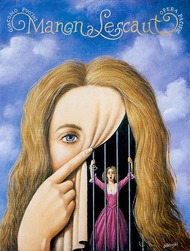
This poster by Rafal Olbinski illustrated the emotions of the main character, Manon, in the French novel Manon Lescaut by Antoine François Prévost. In the picture, Manon's true feelings are hidden "behind bars" underneath a face that hides what she really thinks. The idea that people can keep their inner identity separate from their exterior appearance is a recurring them in literature and artwork. In the book, Manon is dissatisfied with her lover, Chevalier Des Grieux, who cannot fulfill her taste for luxury. She runs away with him to New Orleans but throughout the whole book is not content with her relationship.
"The Thinker" by Auguste Rodin
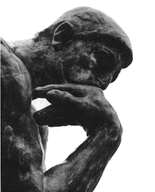
Auguste Rodin created this famous sculpture called "The Thinker". The man in the sculpture is deep in thought, thinking about something. The viewer does not know exactly what he is contemplating. Some people say Auguste Rodin was influenced by the Enlightenment thinker Rene Descartes. Descartes wanted to determine what was true in the world and began with what he knew: his own identity. He stated, "Je pense, donc je suis" (I think, therefore I am.) From this, he was able to deduce everything else that he discovered. This may have been the inspiration from the famous "The Thinker".
"Liberty Leading the People" by Eugene Delacroix
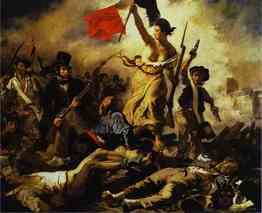
This painting, commemorating the July Revolution of 1830 in France, depict a woman holding the French revolutionary flag leading the opponents of the monarchy. The scene created a powerful image for an event in history that helped the French people win back democracy. Following Napoleon's collapse, the Congress of Vienna reinstated the Bourbons as the hereditary kings of France. Their rule was a symbol of arbitrary power. The Old Regime had been toppled during the 1789 revolution but the monarchy's return to power represented a regression in the advance towards democracy. Delacroix gave the French people newfound pride in their country's government, that had changed hands to Louis Phillipe, the citizen king. The national identity that had been damaged when Louis XVIII came to power was brought back in the July Revolution. The artist's incorporation of elements of romanticism indicate the beauty of fighting for what you believe in.
Works Cited
http://www.lozano-hemmer.com/third_person.php
http://www.jssgallery.org/Other_Artists/Andy_Warhol/campbells.jpg
http://www.ibiblio.org/wm/paint/auth/gogh/self/gogh.bandaged-ear.jpg
http://www.ibiblio.org/wm/paint/auth/gogh/self/gogh.bandaged-ear.jpg
http://www.cartoonstock.com/newscartoons/directory/i/identity.asp
http://3.bp.blogspot.com/_vEOtjqydo88/SwjL45edmfI/AAAAAAAAACQ/PGTiUxreNLo/s1600/School+of+Athens2.jpg
http://images.easyart.com/i/prints/lg/7/5/7574.jpg
http://troy-g.com/category/other-artwork/http://www.abm-enterprises.net/monalisa.jpg
http://3.bp.blogspot.com/_J9ifBwxryUw/TNkI7DjX4XI/AAAAAAAANBU/TmFE3PgOfRA/s1600/Manon%2BLescaut%2Bb.jpg
http://www.americanthinker.com/the_thinker.jpg
http://www.bestpriceart.com/shop-online/images/vault/delacroix5.jpg
http://farm4.static.flickr.com/3083/3331287420_84d59c2078.jpg
http://troy-g.com/2009/03/05/man-of-steel/
http://www.jssgallery.org/Other_Artists/Andy_Warhol/campbells.jpg
http://www.ibiblio.org/wm/paint/auth/gogh/self/gogh.bandaged-ear.jpg
http://www.ibiblio.org/wm/paint/auth/gogh/self/gogh.bandaged-ear.jpg
http://www.cartoonstock.com/newscartoons/directory/i/identity.asp
http://3.bp.blogspot.com/_vEOtjqydo88/SwjL45edmfI/AAAAAAAAACQ/PGTiUxreNLo/s1600/School+of+Athens2.jpg
http://images.easyart.com/i/prints/lg/7/5/7574.jpg
http://troy-g.com/category/other-artwork/http://www.abm-enterprises.net/monalisa.jpg
http://3.bp.blogspot.com/_J9ifBwxryUw/TNkI7DjX4XI/AAAAAAAANBU/TmFE3PgOfRA/s1600/Manon%2BLescaut%2Bb.jpg
http://www.americanthinker.com/the_thinker.jpg
http://www.bestpriceart.com/shop-online/images/vault/delacroix5.jpg
http://farm4.static.flickr.com/3083/3331287420_84d59c2078.jpg
http://troy-g.com/2009/03/05/man-of-steel/
